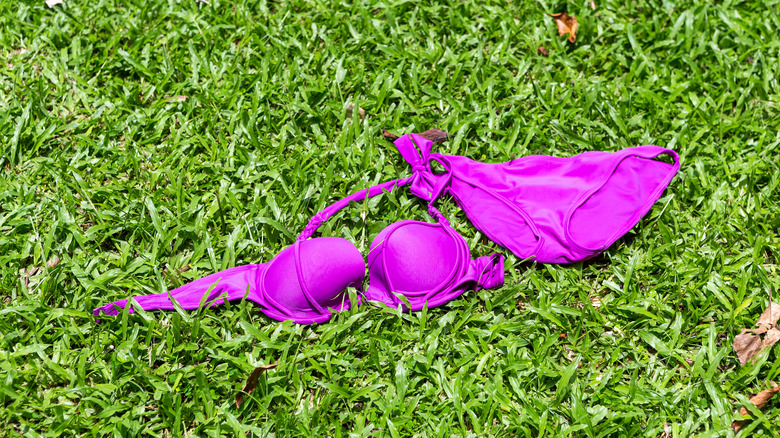Your Guide To Keeping Swimwear In Perfect Condition All Summer
Swimsuits seem fairly durable — whether they're joining you for waterpark rides, swimming laps, or diving from high heights, a well-made suit is the epitome of fashion and function. A wardrobe staple since the 18th century, women's bathing suits have experienced a recent reinvention, with many high-end celebrity brands releasing their own takes on the poolside garb. With everyone from Kim Kardashian to Emily Ratajkowski selling bikinis, there have never been more options (or more price variance) in swimsuit shopping. When you finally invest in your favorite choice, you'll want to make sure it lasts.
While the ideal summer will see you spending very little time out of your swimsuit, what you do in between wears will make all the difference in keeping your swimsuit in tip-top shape. From how you wash it to where you rock it, many factors will impact the longevity of your suit — and the style of your summer — so make sure you're caring for it in a way that will allow you to flaunt your swimwear all season long.
Get ready to wash after every wear
The first truth of swimsuit maintenance may be a tough one to swallow: You're definitely not washing it as often as you should be. Most pools have chlorine, which is added to kill germs. And every pool has water, so ... isn't going swimming basically like washing your swimsuit?
Unfortunately, a dip in the water isn't enough to keep your bikini fresh. In fact, it's part of what gets it so dirty! It's no secret that, despite our best efforts, swimming will often spread germs and expose your body to somewhat unsavory waters. Saltwater swimming areas can wear down your suit's structure, while chlorine will weaken your favorite fabrics.
While the water is certainly part of the problem, it isn't the only reason you need to wash your suit after every wear — so simply donning your suit as you lay out to tan isn't the hack that you think it is. If you're wearing sunscreen (which you should be!), the oils from this product can also soak into your suit and cause damage if it's left to marinate. As Strange Bikinis explains, this combination of factors means that you should, at the very least, be rinsing your swimsuit after every wear.
Hand clean with gentle soaps
It stands to reason that a swimsuit shouldn't need to fear the water. Certainly, swimwear isn't at risk for shrinking or colors bleeding during the rinse cycle. But the washing machine can still be a treacherous place for your favorite suits, especially when high temps and chemical-filled soaps get involved.
The first step in treating your swimsuit like the summer superstar it is? Reading the care instructions. We know — we're used to ignoring those little tags and their mysterious symbols, too. Still, these guides make sense of swimsuits' unique fabrics and teach you how best to care for them. If you generally cut off the tags to create a less scratchy suit, the brand's website is a great place to look. The good news is that most swimsuits are machine washable; the bad news is that you still probably shouldn't.
The New York Times explains that swimsuits are best served with a hand soak in cold-to-room temperature water. Suits that are tossed in the washer should be given the full luxury experience of your most delicate clothing items. Treat them to a mesh laundry bag and a gentle cycle. Super strappy pieces — we see you, string bikini trend — should be secured away from other clothing items that may cause tangles and pull them out of shape.
Dry and store your garments away from the sun
By now, you may have guessed that the toasty, tumbling dryer isn't the best place for your suit. And because no one wants to throw a soggy swimsuit into their laundry basket, you might already be in the habit of hanging bikinis to dry on your shower rod or over the railing of an outdoor balcony.
While air-drying is certainly the way to go, not all methods are created equal. Hanging your swimsuit over a rod or otherwise draping it to dry can cause the garment to lose its shape. As it pulls and lies in a certain position to dry, you may find that your favorite poolside getup no longer fits in the way you desire — and the last thing you want is a stretched-out suit ruining your summer style.
Laying your swimsuit flat in the sun is closer to the ideal drying solution, but the harsh rays of the sun could gradually lead to the garment fading. In a perfect world, you'd lay your suit to dry in a shady area. Although this will take longer, it will help your swimsuit last longer, too! (It almost goes without saying that when it's dry, you'll also want to keep your suit stored out of the sun — not hanging on a peg near the pool, even if it's more accessible that way.)
Be mindful of where you wear your best suits
If you find a swimsuit you love, you may want to rock it all summer long, no matter the occasion. While we're all for wearing what makes you feel confident and happy, you may want to rethink bringing your best suit to certain occasions. Some environments are naturally tougher on swimsuits and thus might be a better fit for older bikinis that you don't mind getting a little more worn down.
As you might expect, taking on body slides at the waterpark might result in some fading and snags as your bottoms take on the brunt of the friction. For the same reasons, you'll want to avoid sitting directly on rough concrete, wooden chairs, or rocky beaches in your favorite bikinis. Lying down a towel is a best practice both for your own comfort and for keeping your suit intact.
One perhaps unexpected culprit for swimsuit damage is the hot tub. Chlorine in general can be tough on fabrics, and the added factor of heat can make the wear more apparent and intense — you may notice fading and a weakening of the suit's elastic properties. While you don't need to worry about the sudden disintegration of your suit mid-soak, the gradual damage may be enough of a concern to warrant saving your favorite suits for non-tubbing days.




